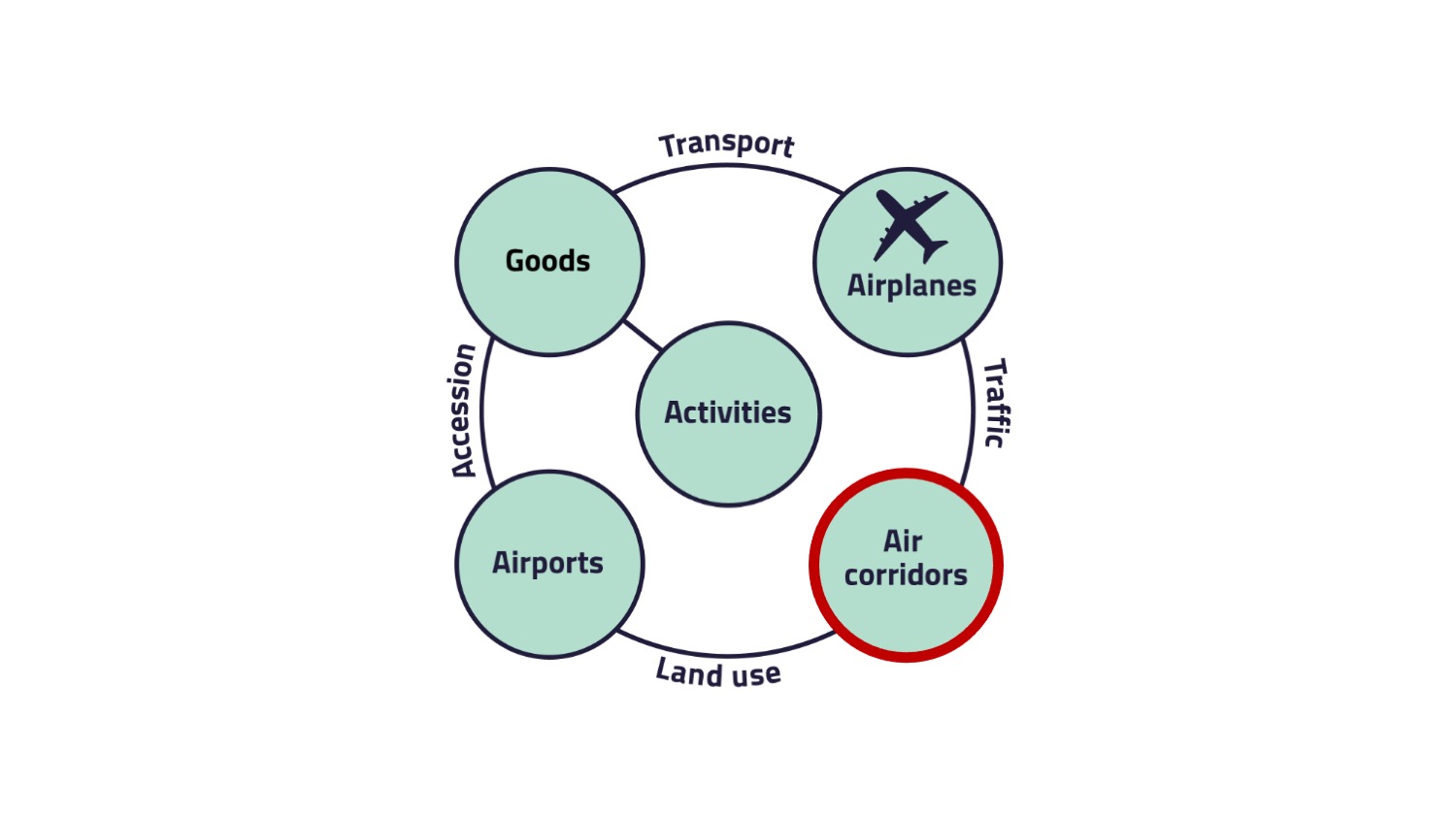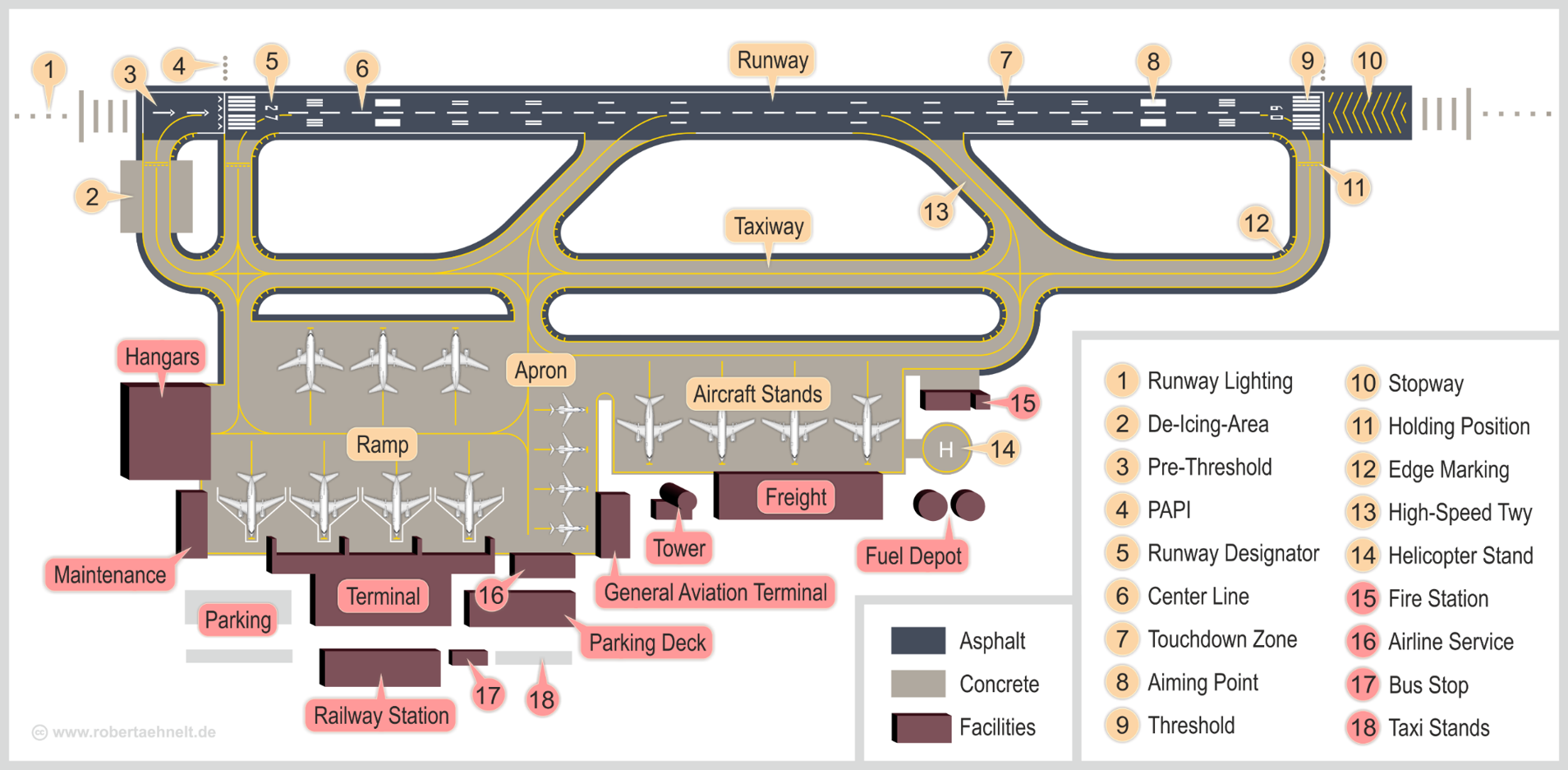Air Transport System
6. Airports
On this page, you will learn more about the element facilities. In the air transport system, the facilities are called "Airports".

International transport chains are always multimodal transport because the location of consignor and consignee are usually not on logistic nodes (exception for example: Airbus).
Therefore, airports are often gateways to large Hinterland regions and are not only for realising modal shift, but are multifunctional hubs, often providing handling and storage functions as well.
According to the Federal Aviation Administration (FAA) (2021), an airport is “any area of land or water used or intended for landing or take-off of aircraft including appurtenant area used or intended for airport buildings, facilities, as well as rights of way together with the buildings and facilities.”
Depending on its size, an airport has different infrastructure such as hangars, aircraft maintenance facilities, ground handling facilities, air traffic control and service facilities for passengers (restaurants, lounges and security services).
Airports link land- and airside modes of transportation and have three main functions.
- Route safety function; which includes ensuring safe take-offs and landings, as well as safeguarding the flow of traffic on the airfields.
- Clearance function; which includes the operational handling of aircrafts as well as the handling of the cargo (passengers, freight or mail).
- Support function; which are focused on the ancillary tasks associated with air traffic. This includes general auxiliary tasks, such as maintenance tasks, as well as special auxiliary tasks that generally serve to satisfy the needs of airline customers and airport visitors.
In Germany, the most important airports for cargo are Frankfurt, Leipzig/Halle and Köln/Bonn.
An exemplary layout of an airport is shown in the following figure.

As you can see, the airport is able to handle passengers and freight. The aircrafts are parked either at the jet bridges (for passengers) or at the aircraft stands at the apron. By using the taxiway, the aircrafts are driving to the runway for takeoff or they are taking the taxiway after landing on the runway to drive to their parking space.
The relation between airports and goods is called accession.
The relation between airports and goods is called accession.
Accession
Accession is an interaction between persons/goods and facilities. It is the provision of options to move persons and goods between the locations of two facilities A and B at specific times. Accession can be just the theoretical possibility of moving between locations at any time, or it could be the planned and even reserved possibility to carry out a transport at a specific point of time. In the first case accession is often measured in required transport time and (if relevant) frequency (time distance between options). In the latter case arrival/delivery within a specific time window is the normal criterion (Just-in-Time).
The accessibility of locations can be considered from three perspectives:
The accessibility of locations can be considered from three perspectives:
From a micro perspective, it is the possibility of goods being handed over to the recipient. Here it is usually construction measures of the building that limit the possibilities of direct transfer of goods (e.g. via a ramp) from the road vehicle to the recipient.
The meso perspective refers to the accessibility of the location of the consignee. Consignees with many suppliers in trade or industry or, for example, on large construction sites often experience traffic jams and significant time losses on the part of the carrier.
The macro perspective is the condition of the infrastructure to access a location. The dimensions (weight and size of the permissible vehicles) play a role here, as do possible restrictions on the time or space available for certain types of vehicle. But also the density of the traffic flow on the infrastructure restricts the accessibility of a location in the macro perspective.
There are a number of air cargo challenges in Germany, some of which are due to limited accessibility:
- overcrowded HUBs (turnaround times at FRA (Frankfurt) up to 12 hours!)
- air traffic control delays at the HUBs
- LEJ (Leipzig/Halle) has no original traffic
- congestion on the highways (travel time to and from FRA up to 8 hours)
- increased costs for ground transport (tolls, driving times for truck drivers, congestion)
- political objectives: Emission reduction (road and air)
- night flight bans, especially FRA, MUC (Munich) and BBI (Berlin-Brandenburg)
You can check your knowledge about airports by answering the following question.
Literature
FAA (2021): Airport Categories Airports. URL: https://www.faa.gov/airports/planning_capacity/categories/ (last access: 30.03.2022).
Flämig, H., Sjöstedt, L., Hertel, C. (2002): Multimodal Transport: An Integrated Element for Last-Mile-Solutions? Proceedings, part 1; International Congress on Freight Transport Automation and Multimodality: Organisational and Technological Innovations. Delft, 23 & 24 May 2002. (modification of Sjöstedt 1996)
Flämig, H., Sjöstedt, L., Hertel, C. (2002): Multimodal Transport: An Integrated Element for Last-Mile-Solutions? Proceedings, part 1; International Congress on Freight Transport Automation and Multimodality: Organisational and Technological Innovations. Delft, 23 & 24 May 2002. (modification of Sjöstedt 1996)
Rößger, E.; Haucke, K.; Hünermann, B.; Jaden, E. (1970): Airport Functions: Die Bedeutung eines Flughafens für die Wirtschaft in seiner Umgebung